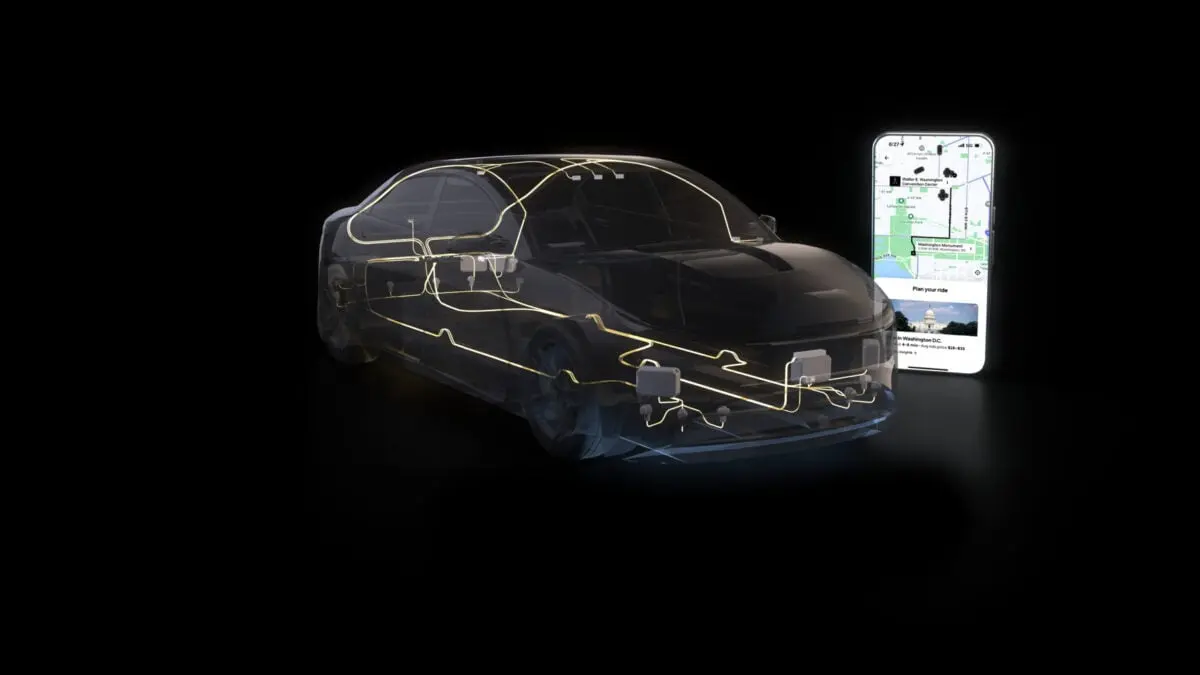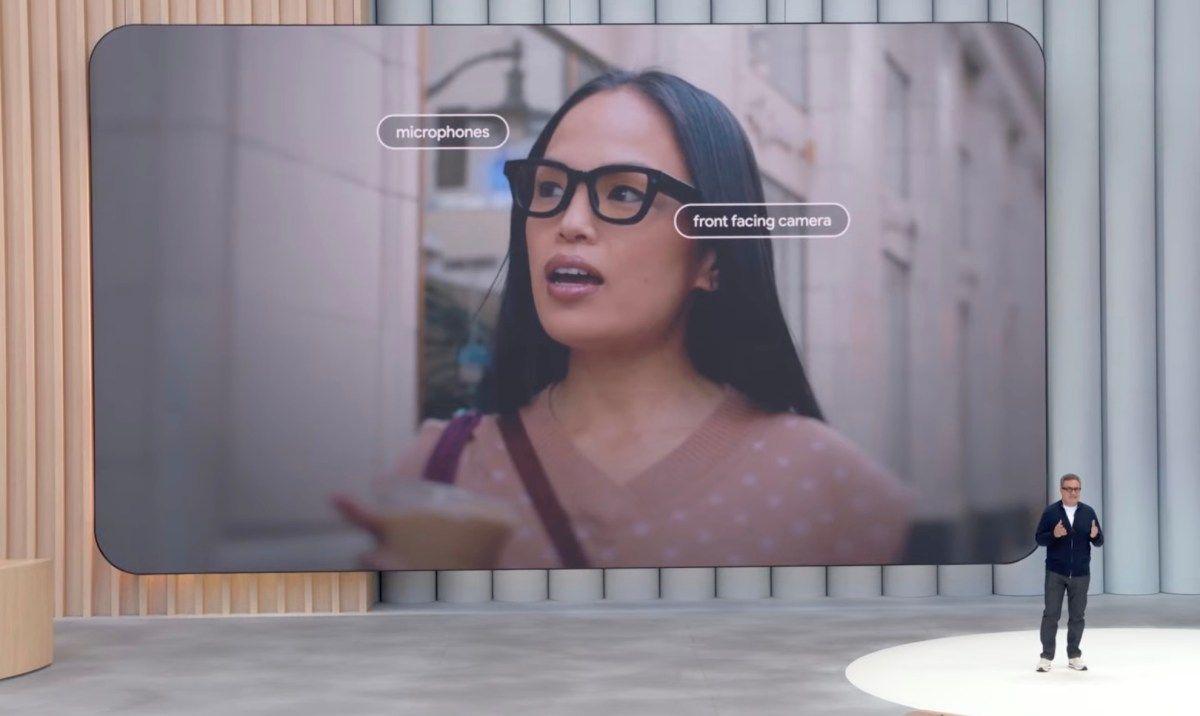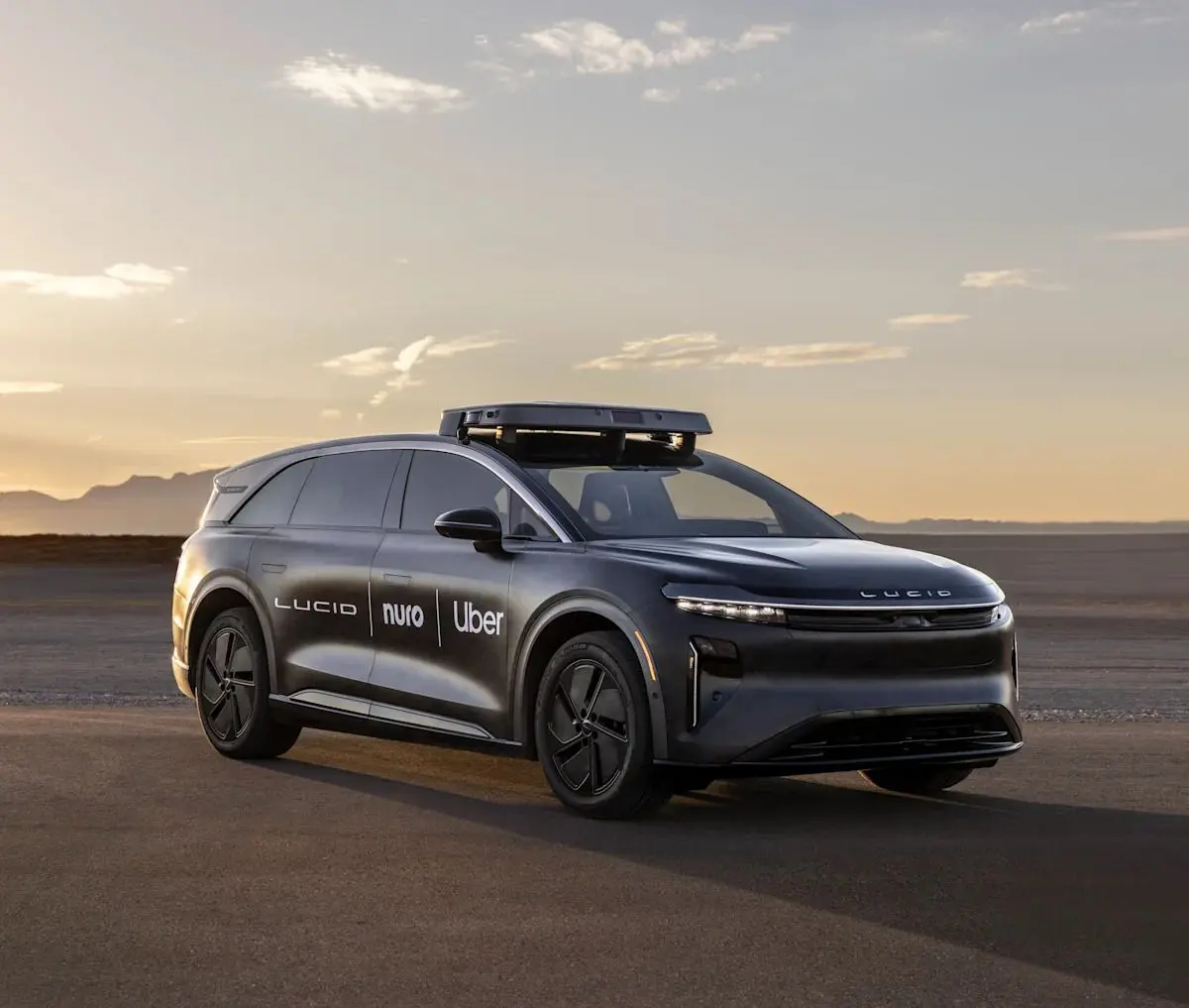Uber Partners with Nvidia to Accelerate Autonomous Vehicle Development
9 Sources
9 Sources
[1]
Uber Partners with Nvidia, backs Autonomous Vehicle technology
Uber has announced a partnership with Nvidia to accelerate the development of autonomous vehicles (AV). Announced at CES 2025, this collaboration aims to use Nvidia's AI platforms, Cosmos and DGX Cloud, to fast-track advancements in self-driving systems. "Generative AI will power the future of mobility, requiring both rich data and very powerful compute. By working with NVIDIA, we are confident that we can help supercharge the timeline for safe and scalable autonomous driving solutions for the industry," Uber CEO Dara Khosrowshahi said, as per the release. Uber has long been interested in autonomous vehicles (AVs) as the next frontier for transportation. The aim is not only to reduce operational costs by removing the human driver element but also to improve safety, efficiency, and accessibility of transport. However Uber's journey has been fraught with challenges that includes legal battles and accidents which then forced the company to focus more on partnerships rather than in-house development. Nvidia, on the other hand, has emerged as a key player in AI and robotics providing the foundational tools for companies aiming to build autonomous systems. Uber's past attempts at self-driving technology faced hurdles. In 2015, the company launched its self driving unit, the Advanced Technologies Group (ATG), but encountered setbacks including a fatal accident in Arizona and legal battles with Waymo over intellectual property. Uber eventually sold ATG to Aurora Innovation in 2020. Since then, Uber has shifted to a partnership-driven approach, collaborating with companies like Waymo, Aurora, and Serve Robotics. Nvidia has positioned itself as one of the central players of AI and robotics innovation. The chipmaker has now expanded into AI supercomputing and AI robotics. Nvidia's Cosmos platform uses physics-based simulations to generate realistic environments for training AI models. Its DGX Cloud provides scalable AI infrastructure enabling companies to train, fine-tune and deploy advanced models. India's resistance to AVs serves as a reminder that the global rollout of autonomous vehicles will not be uniform. The journey toward driverless cars in India may still be uncertain, but efforts to develop cleaner, safer and more advanced vehicles are already underway. The Ministry of Road Transport and Highways introduced India's own crash test rating system Bharat NCAP back in June, 2022. While companies like Uber and Nvidia are accelerating the global adoption of autonomous vehicles, India is taking a cautious approach to it. Union Minister for Road Transport and Highways, Nitin Gadkari in 2023 had said that driverless cars will not be allowed in the country. Gadkari's concerns stem from the potential loss of jobs in a nation heavily reliant on drivers job for employment, as per media reports.
[2]
Uber Teams Up with NVIDIA to Accelerate Autonomous Mobility
Uber Technologies, Inc. (NYSE: UBER) and NVIDIA announced they are collaborating on new solutions to support the development of AI-powered autonomous driving technology. "Generative AI will power the future of mobility, requiring both rich data and very powerful compute," said Dara Khosrowshahi, CEO of Uber. "By working with NVIDIA, we are confident that we can help supercharge the timeline for safe and scalable autonomous driving solutions for the industry." Millions of trips occur every day on Uber, representing a vast and rich source of data that the companies will look to pair with the NVIDIA Cosmos™ platform and NVIDIA DGX™ Cloud to help AV partners build stronger AI models even more efficiently. NVIDIA Cosmos is a new platform of state-of-the-art generative world foundation models, tokenizers, and accelerated data processing and model customization pipelines, purpose-built for developing physical AI systems like robots and autonomous vehicles. Cosmos eliminates cost and resource barriers, helping democratize access to tools for developing physical AI. NVIDIA DGX Cloud is a high-performance, fully managed AI platform preconfigured with the latest NVIDIA architecture and software. Providing term-length flexibility and machine learning pipeline portability on an open platform, DGX Cloud delivers day-one productivity and maximum resource utilization for AI model development across multi-cloud environments. "Uber is one of the first mobility leaders to embrace these platforms to accelerate the development and deployment of physical AI systems such as AVs," said Norm Marks, vice president of automotive at NVIDIA. "We're excited to collaborate with Uber to help empower the AV ecosystem with Cosmos and DGX Cloud." The companies will share additional details later this year. About Uber Uber's mission is to create opportunity through movement. We started in 2010 to solve a simple problem: how do you get access to a ride at the touch of a button? More than 55 billion trips later, we're building products to get people closer to where they want to be. By changing how people, food, and things move through cities, Uber is a platform that opens up the world to new possibilities.
[3]
Uber And NVIDIA Partner On AI Technology For Autonomous Cars - NVIDIA (NASDAQ:NVDA), Uber Technologies (NYSE:UBER)
NVIDIA's Cosmos and DGX Cloud platforms will power Autonomous Vehicle development. Uber Technologies Inc. UBER shares are trading higher premarket on Tuesday after the ride-ailing company and NVIDIA Corporation NVDA entered into a strategic partnership aimed at advancing AI-powered autonomous vehicle (AV) technology. The collaboration will leverage NVIDIA's platforms, including Cosmos and DGX Cloud, to accelerate the development of autonomous driving solutions. NVIDIA Cosmos is a state-of-the-art platform designed to support the development of physical AI systems like robots and autonomous vehicles, eliminating cost and resource limitations, making it easier for developers to build and deploy AI models at scale. Additionally, NVIDIA DGX Cloud offers a high-performance, fully managed environment for AI model development. Also Read: Uber CFO Says Stock Undervalued, Initiates $1.5 Billion Accelerated Stock Buyback By combining Uber's trove of mobility data with NVIDIA's AI technology, both companies plan to create more efficient and scalable AI models for the industry. "Generative AI will power the future of mobility, requiring both rich data and very powerful compute," said Uber CEO Dara Khosrowshahi. "By working with NVIDIA, we are confident that we can help supercharge the timeline for safe and scalable autonomous driving solutions for the industry." In his keynote address at the CES 2025 on Monday, NVIDIA CEO Jensen Huang predicted that self-driving vehicles would become "the first multi-trillion dollar robotics industry." Nvidia will also deploy its Drive AGX Orin supercomputer and operating system for advanced driver assistance features on Toyota Motor Corp's next-generation models. "NVIDIA is bringing two decades of automotive computing, safety expertise and its CUDA AV platform to transform the multitrillion dollar auto industry," said Huang. Price Action: UBR shares are trading higher by 2.26% at $67.81 in premarket at last check Tuesday. Related Read: Uber CEO Dara Khosrowshahi Resigns From Board Of Autonomous Vehicle Tech Company Aurora Image via Shutterstock. Market News and Data brought to you by Benzinga APIs
[4]
Uber Teams Up with NVIDIA to Accelerate Autonomous Mobility By Investing.com
Joint initiative will leverage NVIDIA (NASDAQ:NVDA)'s new Cosmos platform and DGX Cloud to boost autonomous development SAN FRANCISCO--(BUSINESS WIRE)--Uber Technologies, Inc. (NYSE: UBER) and NVIDIA announced they are collaborating on new solutions to support the development of AI-powered autonomous driving technology. Generative AI will power the future of mobility, requiring both rich data and very powerful compute, said Dara Khosrowshahi, CEO of Uber. By working with NVIDIA, we are confident that we can help supercharge the timeline for safe and scalable autonomous driving solutions for the industry. Millions of trips occur every day on Uber, representing a vast and rich source of data that the companies will look to pair with the NVIDIA Cosmos™ platform and NVIDIA DGX™ Cloud to help AV partners build stronger AI models even more efficiently. NVIDIA Cosmos is a new platform of state-of-the-art generative world foundation models, tokenizers, and accelerated data processing and model customization pipelines, purpose-built for developing physical AI systems like robots and autonomous vehicles. Cosmos eliminates cost and resource barriers, helping democratize access to tools for developing physical AI. NVIDIA DGX Cloud is a high-performance, fully managed AI platform preconfigured with the latest NVIDIA architecture and software. Providing term-length flexibility and machine learning pipeline portability on an open platform, DGX Cloud delivers day-one productivity and maximum resource utilization for AI model development across multi-cloud environments. Uber is one of the first mobility leaders to embrace these platforms to accelerate the development and deployment of physical AI systems such as AVs, said Norm Marks, vice president of automotive at NVIDIA. We're excited to collaborate with Uber to help empower the AV ecosystem with Cosmos and DGX Cloud. The companies will share additional details later this year. About Uber Uber's mission is to create opportunity through movement. We started in 2010 to solve a simple problem: how do you get access to a ride at the touch of a button? More than 55 billion trips later, we're building products to get people closer to where they want to be. By changing how people, food, and things move through cities, Uber is a platform that opens up the world to new possibilities.
[5]
Uber stock rises on Nvidia partnership for autonomous tech By Investing.com
The collaboration, revealed in a recent press release, is set to advance Uber's capabilities in the realm of autonomous vehicles (AVs) by leveraging Nvidia's AI platforms. Uber's CEO, Dara Khosrowshahi, stated, "Generative AI will power the future of mobility, requiring both rich data and very powerful compute." He believes that working with Nvidia will substantially expedite the timeline for creating safe and scalable autonomous driving solutions. The data from millions of Uber's daily trips will be used in conjunction with Nvidia's Cosmos platform and DGX Cloud to assist AV partners in building more robust AI models. Nvidia Cosmos is designed to eliminate cost and resource barriers in the development of physical AI systems, such as robots and autonomous vehicles. Meanwhile, the DGX Cloud offers a high-performance, fully managed AI platform that facilitates AI model development across multi-cloud environments. Norm Marks, vice president of automotive at Nvidia, expressed enthusiasm about the collaboration, stating that Uber is among the first mobility leaders to adopt these platforms. This partnership is expected to empower the AV ecosystem with advanced tools and platforms, with further details to be shared later in the year. This strategic move by Uber reflects the company's ongoing efforts to position itself at the forefront of the AV industry, an area that continues to captivate investor interest. The market's positive reaction to this news underscores the significance of AI and AV technology in shaping the future of transportation. The partnership is a clear signal of Uber's commitment to innovation in the fast-evolving field of autonomous driving, and it highlights the potential for transformative changes in how people and goods are moved. With both companies set to benefit from this collaboration, investors will be watching closely for the impact it will have on Uber's growth trajectory and its position in the competitive landscape of autonomous mobility.
[6]
At CES 2025, Uber teams up with Nvidia to scale autonomous driving faster | TechCrunch
Uber will use Nvidia's new generative world model simulation tool, Cosmos, and cloud-based AI supercomputing platform, DGX Cloud, to support the development of autonomous vehicle technology, the companies announced at CES 2025. Cosmos is being marketed to robotics and autonomy companies as a tool that generates physics-based videos from a variety of inputs, including 9,000 trillion tokens generated from 20 million hours of (likely copyrighted) video, which can be used to simulate realistic industrial and driving environments. Nvidia DGX Cloud would provide Uber and other companies with access to high-performance AI infrastructure to train, fine-tune, and deploy AI self-driving models. Uber shared few details about how it plans to use these Nvidia tools. The ride-hail and delivery giant has spent the last year racking up 14 partnerships with AV companies across verticals, from Waymo in robotaxis to Aurora Innovation in trucking to Serve Robotics in sidewalk robotic delivery. Perhaps Uber will hand over its vast data on how and where people use ride-hail and delivery, working in tandem with such partners. The company doesn't develop its own AV technology, preferring instead the asset-light approach of partnering with others. That's not for lack of trying; Uber's history with AV development is troubled. Uber launched its self-driving unit, Uber ATG, in 2015 through a partnership with Carnegie Mellon University's National Robotics Center. A year later, the company acquired self-driving truck startup Otto, which was founded by one of Google's star engineers, Anthony Levandowski. Uber later shuttered its trucking tech unit to focus on self-driving cars. But some damage had been done by bringing Levandowski on board. Waymo accused him of stealing trade secrets, which they alleged were then used by Uber. The case ended in a settlement in 2018, and Levandowski was later sentenced to 18 months in prison before he was pardoned by then-President Donald Trump. Also in 2018, an Uber self-driving vehicle testing in autonomous mode in Arizona struck a pedestrian, who later died as a result of her injuries. The next year, Uber spun out Uber ATG after closing $1 billion in funding from Toyota, but then in 2020, sold it off to autonomous vehicle startup Aurora Innovation. Today, Uber seems committed to being the bridge between rider and driver, whether that's a human or robot driver. But that doesn't mean Uber is comfortable moving slowly. During the company's third-quarter earnings report, Uber CEO Dara Khosrowshahi explained that the company is launching with Waymo in only two cities this year -- Austin and Atlanta -- due to the investment that goes into launch. "What you want to get is the proper liquidity in a city anytime that you launch," Khosrowshahi said in response to an analyst question. "You want to go into a city with the proper investment in your depots, in your infrastructure, in your mapping, etc., so that you can start getting a return on capital." It takes time to lay the groundwork for AV deployment in a new city, but it looks like Uber thinks that with Nvidia's world models and cloud platform, it can get to scale quicker. "By working with Nvidia, we are confident that we can help supercharge the timeline for safe and scalable autonomous driving solutions for the industry," Khosrowshahi said in a statement. Uber would not share any additional details with TechCrunch.
[7]
Uber, Nvidia Partnership To Unlock Value By Leveraging AI To Advance Ridesharing, Autonomous Tech: Analyst - Uber Technologies (NYSE:UBER)
Analyst backs Uber's AV push, citing strong data advantage for ridesharing and partnerships with top auto OEMs like Toyota. BofA Securities analyst Justin Post maintained a Buy rating on Uber Technologies Inc UBER with a price target of $96 after the ride-hailing giant announced a partnership with NVDIA Corp NVDA to collaborate on autonomous vehicle enablement. The price target reflects a 20 times 2026E FCF multiple, which Post deems reasonable versus the FANG average of 28 times, given Uber's strong 2026E EBITDA growth outlook of 28% versus the FANG average of 17%. The collaboration is focusing on supporting the development of AI-powered autonomous driving (AVs), pairing Uber's dataset of millions of daily trips with Nvidia's new Cosmos platform (first announced at CES) and Nvidia DGX Cloud. Cosmos is Nvidia's new generative AI platform. It focuses on "physical AI systems," creating synthetic environments and eliminating cost barriers to developing advanced robotics. Also Read: Uber and Lyft Adapt Robotaxi Strategy to Compete in Tesla and Waymo's Space Nvidia DGX Cloud offers a fully managed AI platform preconfigured with advanced Nvidia architecture and software on "an open platform" for AI model development across multi-cloud environments. Uber will likely commit significant resources, given the importance of this strategy to the business. Nvidia chief Jensen Huang noted at CES that Cosmos is the world's first foundational model tailored explicitly for "Physical AI." He said autonomous vehicles will be the first multi-trillion-dollar robotics industry. He announced a partnership with Toyota, with Toyota's next-gen vehicles using Nvidia's Drive AGX Orin supercomputers and operating system DriveOS for real-time AI processing and integration of advanced driving and cockpit features. He also announced a next-gen chip tailored for AVs called "Drive Thor," an advancement from its prior "Drive Orin" chip, enabling auto OEMs to more efficiently consolidate multiple functions in a single system, reducing overall system cost. The variety of AV partnerships and products announced at CES underscores Post's thesis that multiple auto OEMs will integrate Level 4 self-driving technology long term, providing Uber with multiple available partners in AV ridesharing, including Uber, Toyota Motor Corp TM, Aurora Innovation, Inc AUR with its self-driving trucks, and automotive supplier Continental. With numerous new AV competitors -- Alphabet Inc.'s GOOG GOOGL Waymo, Tesla Inc TSLA, Amazon.com Inc.'s AMZN Zoox -- Post noted auto OEMs will increasingly focus on integrating Level 4 autonomy. For Uber, providing data and ride imaging/video in an increasingly open-sourced manner could help auto OEMs reach Level 4 more quickly and effectively reduce the likelihood of a "Walled Garden" outcome for only one OEM. Uber's data could also have an advantage in addressing the ridesharing use case, with higher-quality data on the most essential trips and routes for ride-hailing. Uber is one of Post's top picks for 2025. UBER Price Action: Uber stock is down by 2.72% at $64.35 at publication Wednesday. Also Read: Stellantis, Volkswagen Stocks Tumble As US EV Tax Credits Disappear Photos: Shutterstock Market News and Data brought to you by Benzinga APIs
[8]
Uber stock rises on Nvidia pact By Investing.com
Investing.com -- Uber Technologies (NYSE:UBER) shares have risen by 3.5% in premarket trading Tuesday after the company announced it has teamed up with Nvidia Corporation (NASDAQ:NVDA) to accelerate autonomous mobility. They explained that the collaboration aims to accelerate the development through the integration of Nvidia's advanced AI platforms. The joint initiative will leverage Nvidia's Cosmos platform and DGX Cloud, designed to enhance the efficiency and scalability of AI-powered autonomous driving systems. Dara Khosrowshahi, CEO of Uber, said the partnership is important to expedite the safe deployment of autonomous mobility solutions. "Generative AI will power the future of mobility, requiring both rich data and very powerful compute," Khosrowshahi stated. Uber's extensive network, which facilitates millions of trips daily, provides a vast data resource that will be instrumental in developing robust AI models. The partnership seeks to harness this data using Nvidia's cutting-edge Cosmos platform and DGX Cloud. Nvidia's Cosmos platform offers generative models, tokenizers, and data processing tools specifically tailored for physical AI systems like autonomous vehicles. It aims to lower the barriers to AI development, democratizing access to advanced tools. Meanwhile, the DGX Cloud is a high-performance AI platform providing flexibility and productivity for AI model development across multiple cloud environments. Norm Marks, vice president of automotive at Nvidia, said, "Uber is one of the first mobility leaders to embrace these platforms to accelerate the development and deployment of physical AI systems such as AVs."
[9]
Uber Shares Edge Higher on AI Autonomous Driving Deal with Nvidia
Shares of Uber Technologies rose a day after the ride-hailing company said it is partnering with Nvidia to develop AI-powered autonomous driving technology. The stock was up 2.9% to $68.21 in pre-market trading Tuesday. Through Monday's close, shares have climbed 15% over the past 12 months. The San Francisco-based company said both parties will pair the data coming from Uber's trips with the Nvidia Cosmos platform and Nvidia DGX Cloud to help Uber's autonomous vehicles partners build stronger AI models more efficiently. The companies didn't share financial details of the agreement, but are expected to provide more information later this year. "By working with Nvidia, we are confident that we can help supercharge the timeline for safe and scalable autonomous driving solutions for the industry," Uber's Chief Executive Dara Khosrowshahi said. Nvidia Cosmos platform builds physical AI systems like robots and autonomous vehicles, while the Nvidia DGX Cloud allows maximum resource utilization for AI model development across multi-cloud environments. Write to Sabela Ojea at [email protected]; @sabelaojeaguix
Share
Share
Copy Link
Uber and Nvidia announce a strategic partnership to advance AI-powered autonomous vehicle technology, leveraging Nvidia's Cosmos platform and DGX Cloud to process Uber's vast mobility data.

Uber and Nvidia Join Forces for Autonomous Vehicle Innovation
In a significant move that could reshape the future of transportation, Uber Technologies, Inc. and NVIDIA have announced a strategic partnership aimed at accelerating the development of autonomous vehicles (AVs). The collaboration, unveiled at CES 2025, will leverage NVIDIA's cutting-edge AI platforms to process Uber's extensive mobility data, potentially fast-tracking advancements in self-driving systems
1
.The Power of Data and AI
At the heart of this partnership is the fusion of Uber's vast trove of trip data with NVIDIA's advanced AI technologies. Uber, which facilitates millions of trips daily, will provide a rich source of real-world mobility data. This data will be paired with NVIDIA's Cosmos platform and DGX Cloud to help AV partners build more robust AI models
2
.NVIDIA's Technological Contributions
NVIDIA brings two key technologies to the table:
-
Cosmos Platform: A state-of-the-art platform featuring generative world foundation models, tokenizers, and accelerated data processing pipelines. It's designed to democratize access to tools for developing physical AI systems like robots and autonomous vehicles
3
. -
DGX Cloud: A high-performance, fully managed AI platform preconfigured with the latest NVIDIA architecture and software. It offers flexibility and portability for AI model development across multi-cloud environments
4
.
Implications for the AV Industry
This collaboration is expected to have far-reaching implications for the autonomous vehicle industry. Uber CEO Dara Khosrowshahi emphasized the role of generative AI in shaping the future of mobility, stating that the partnership with NVIDIA could "supercharge the timeline for safe and scalable autonomous driving solutions for the industry"
5
.Related Stories
Uber's Evolving AV Strategy
The partnership marks a significant shift in Uber's approach to autonomous vehicle technology. After facing setbacks with its in-house development efforts, including the sale of its Advanced Technologies Group (ATG) to Aurora Innovation in 2020, Uber has pivoted to a partnership-driven strategy. This collaboration with NVIDIA aligns with Uber's new focus on leveraging external expertise and resources in the AV space
1
.Market Response and Future Outlook
The announcement has been well-received by the market, with Uber's stock price rising in response to the news. This positive reaction underscores the significance of AI and AV technology in shaping the future of transportation and highlights the potential for transformative changes in urban mobility
5
.As the partnership unfolds, both companies have promised to share additional details later in the year. The collaboration between Uber and NVIDIA represents a significant step forward in the quest for safe and scalable autonomous driving solutions, potentially accelerating the timeline for widespread AV adoption.
References
Summarized by
Navi
[2]
Related Stories
Nvidia and Uber Partner to Deploy 100,000 Robotaxis by 2027
29 Oct 2025•Business and Economy

Nvidia Expands AI Partnerships for Next-Generation Autonomous Vehicles
07 Jan 2025•Technology

GM and Nvidia Forge Expansive Partnership to Revolutionize Automotive AI and Autonomous Driving
19 Mar 2025•Technology

Recent Highlights
1
AI Chatbots Sway Voters More Effectively Than Traditional Political Ads, New Studies Reveal
Science and Research

2
Google AI glasses set to launch in 2026 with Gemini and Android XR across multiple partners
Technology

3
EU Launches Antitrust Probe Into Google's AI Training Practices and Content Usage
Policy and Regulation




